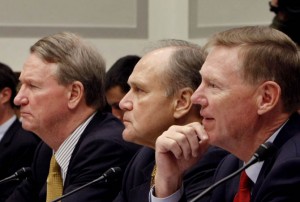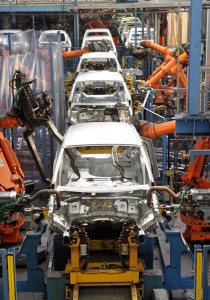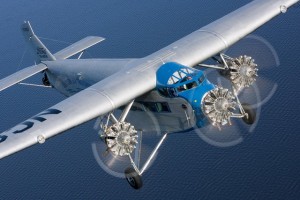Scott Spangler at Jetwhine recently opined that business jets are “merely pawns in the war over wealth”. His article was prompted by a snarky New York Times op-ed which gleefully zinged Texas governor Rick Perry for his frequent business jet travel.
While I don’t disagree with Spangler’s assertion, his missive got me wondering why American business is so timid about extolling the virtues of corporate aviation. They know the benefits of a business jet better than anyone, yet it’s virtually unheard of for any firm large enough to have a corporate aircraft to crow about what it does for them.
I know, I know: NBAA, GAMA, AOPA, and other industry alphabet groups have been trying to get the word out via No Plane/No Gain, GA Serves America, and other such campaigns. Those programs are well and good, but they’re passive efforts, not active ones.
I can’t recall the last time I saw a solid defense of business aviation to anything other than an aviation-friendly audience. What we need is a forceful push from people in the spotlight, folks like the aforementioned Texas governor, corporate leaders at annual meetings, experts giving media interviews, and those called on to provide Congressional testimony. When belittled about their business aviation activity, these individuals must speak out strongly and without fear, because the facts are wholly in their favor.
Instead, what we’ve been giving the general public for the past several years has been the polar opposite: mealy-mouthed statements, apologies, diversions, or even outright silence, followed by the curtailing or elimination of the flying that gives their company a competitive edge. Unless the institution in the spotlight is governmental, that is. But more on that later.

The most egregious example of a missed opportunity was in 2008. Incidentally, it was also the event which started the mainstream vilification of business aviation in the first place. CEOs of the Big Three automakers — Ford, GM, and Chrysler — appeared before the House Financial Services Committee to appeal for a $25 billion dollar federal bailout.
They had each flown to Washington via private jet and were excoriated by the committee for it. So much so, in fact, that the next time they testified before Congress, they drove themselves from Detroit to Washington, D.C.
“There is a delicious irony in seeing private luxury jets flying into Washington, D.C., and people coming off of them with tin cups in their hand, saying that they’re going to be trimming down and streamlining their businesses,” Rep. Gary Ackerman, D-New York, told the chief executive officers of Ford, Chrysler and General Motors at a hearing of the House Financial Services Committee.
“It’s almost like seeing a guy show up at the soup kitchen in high hat and tuxedo. It kind of makes you a little bit suspicious.”
He added, “couldn’t you all have downgraded to first class or jet-pooled or something to get here? It would have at least sent a message that you do get it.”
At Wednesday’s hearing, Rep. Brad Sherman, D-California, pressed the private-jet issue, asking the three CEOs to “raise their hand if they flew here commercial.”
“Let the record show, no hands went up,” Sherman said. “Second, I’m going to ask you to raise your hand if you are planning to sell your jet in place now and fly back commercial. Let the record show, no hands went up.”
The executives did not specifically respond to those remarks. In their testimony, they said they are streamlining business operations in general.

The automotive CEOs dug their own graves in that moment, and the rest of us have been paying the price ever since. Why didn’t Mulally explain that Ford Motor Company has assembly plants, parts warehouses, suppliers, dealerships, design centers, test tracks, and racing teams all over the planet? The company operates 24 hours a day, every day of the year, and when an engineering fault is discovered on a factory floor, it can idle that entire plant until the flaw is fixed. It requires engineers, and how are they supposed to get there? On an airliner?
Sure, send your team to the airport to take an inconveniently timed flight. They’ll have to be there two hours in advance so they can clear security, then if they’re lucky and the flight is not delayed, they eventually arrive at a major hub and then transfer to another aircraft that still won’t get them as close to the plant as a business jet could (fact: there are 250 commercial airports, but more than 5,000 general aviation airports in the U.S. alone). That makes no sense when an idled plant can cost the company hundreds of thousands of dollars every hour it’s shut down. Unless you’re a politician, of course.
Or when a NASCAR, NHRA, Grand-Am, or rally team sponsored and/or powered by Ford calls needing a part or because they’re having trouble with that Ford engine before a race, forget about sending support personnel and parts on the corporate jet. Send it UPS. Sure, it won’t get there until it’s too late to qualify, but hey, there are only a few million fans watching that race on TV. So the Ford logo won’t appear, who cares. It’s not like that costs money, right?
Ford is competing against increasingly efficient companies from South Korea, Japan, and many other places. They have to turn out the best designs and put them into production as quickly and efficiently as possible. Time is money, and business jets give Ford it’s edge (no pun intended), to say nothing of the fact that Ford has been involved in the aviation industry for as long as that industry has existed.

The Ford Trimotor was the first successful airliner and is an important enough part of aviation history that one hangs in the Smithsonian Air & Space Museum. Ford manufactured thousands of airplanes during World War II, at one point cranking out a B-24 bomber every hour. Even today the B-52 bomber flies with some Ford parts on it. Ford started an airline, had its own airport (which by the way hosted the first paved runway in the world). In 1909 Henry Ford helped build his first airplane. The Thunderbird and Mustang were named after airplanes.
You can’t separate Ford Motor Company from the history of aviation, past or present. They wouldn’t have been successful without it in the past and cannot achieve greatness in the future without it, either. That’s what Mulally should have said.
As far as executives are concerned, they aren’t the primary users of corporate jets. That’s just a fact. But when executives do use the company jet, it’s not only the most efficient way to travel, but it actually saves money. For one thing, CEOs at that level don’t travel alone. They bring people with them. They work on the airplane. And when you add up the total cost of last-minute, first class round-trip tickets for all those people (don’t forget taxes and fees!), the business jet suddenly becomes much more cost effective.

Think about what a CEO makes on an hourly basis. If he works 60 hours a week, Mulally’s $24 million annual salary breaks down at about $7,750 per hour. He’s probably traveling with people who make another few hundred dollars per collective hour. Let’s call it $9,000/hour total. Does it make sense to have them working aboard the airplane where they have access to secured Internet, company intranet, and telephone service? Or are the firm and its shareholders better served by having them sit in a crowded airline terminal where it’s too loud and public to discuss company business?
The ultimate insult is that while government representatives are belittling corporate America for their use of business jets, that very same government is busy buying and flying the largest and most expensive corporate jets on the planet for their own use.
In August of 2009, at the height of the financial crisis, the Wall Street Journal reported that the U.S. government had three 737s, two Gulfstream Vs, and eighteen other aircraft in the Washington, D.C. area for Congressional use. The government at this point was already spending in excess of $1,000,000,000,000 more than it received every single year. Government finances were in a worse place than any automotive company, so you’d think the Members of Congress would be ditching their business jets.
Au contraire. They were authorizing the purchase of eight additional jets for a cool $550 million.
Congress plans to spend $550 million to buy eight jets, a substantial upgrade to the fleet used by federal officials at a time when lawmakers have criticized the use of corporate jets by companies receiving taxpayer funds.
Why didn’t the automotive CEOs ask members of the House committee about that? They should bring it up, along with the benefits of business aviation, ever single time the issue is raised by the media. Better yet, the very users of those jets should be shouting it from the rooftops. They should be broaching the issue at every available opportunity, because with China, India, Brazil, and South Korea investing heavily in business aviation and it won’t be long before their competitiveness surpasses our own.

